
For this edition of Classic Steel, we are going to take a look back at how the 250 class of 1993 stacked up in the magazines of the time.
 There were lots of great choices available in the 1993 250 class and all of them offered very different takes on the ultimate deuce-and-a-half package. Photo Credit: Karel Kramer
There were lots of great choices available in the 1993 250 class and all of them offered very different takes on the ultimate deuce-and-a-half package. Photo Credit: Karel Kramer
In 1993, the 250 class offered one of the most competitive lineups in the sport’s history. Two of the main contenders were all-new in 1992 and the other three were all-new for the 1993 season. Yamaha, KTM, and Suzuki all released major redesigns of their 250 platforms, with Honda and Kawasaki dialing up a substantial list of updates for their sophomore outings. All the machines offered inverted cartridge forks, dual-disc brakes, and potent power valve-equipped motors. While the level of technology was higher than ever across the board, there remained distinct differences that set each machine apart.
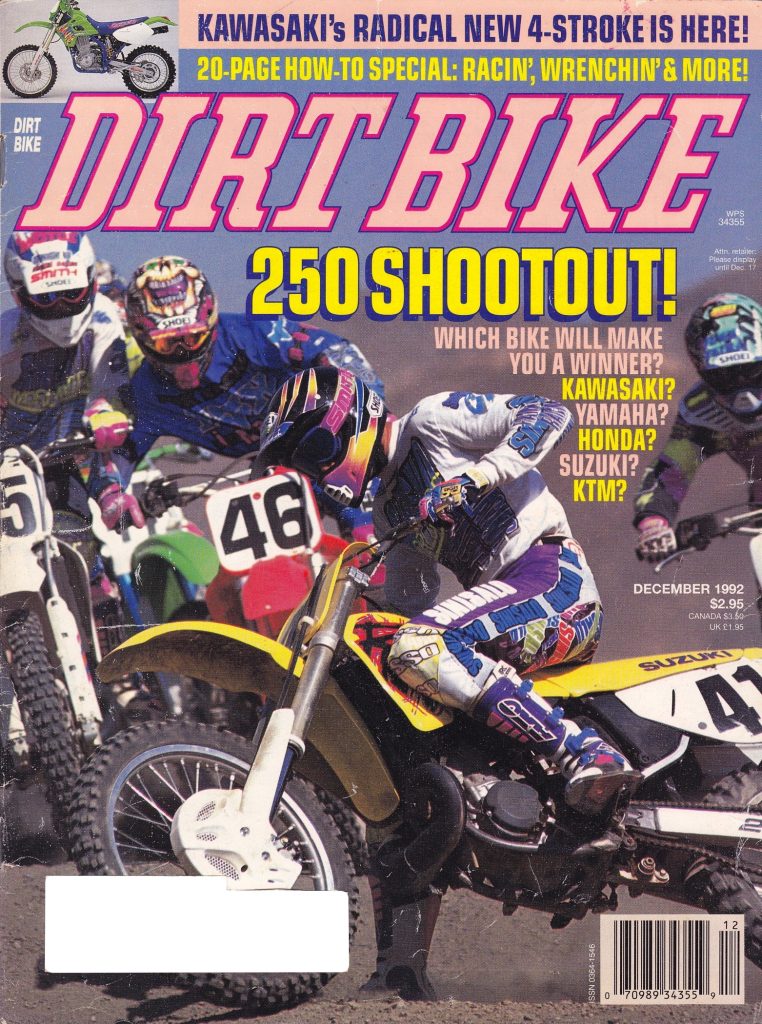 Dirt Bike’s shootout was the headliner but the KLX650 was a pretty big deal as well. Unfortunately for green thumper fans, the big KLX never managed to make much of a dent in Honda’s dominant big-bore four-stroke position.
Dirt Bike’s shootout was the headliner but the KLX650 was a pretty big deal as well. Unfortunately for green thumper fans, the big KLX never managed to make much of a dent in Honda’s dominant big-bore four-stroke position.
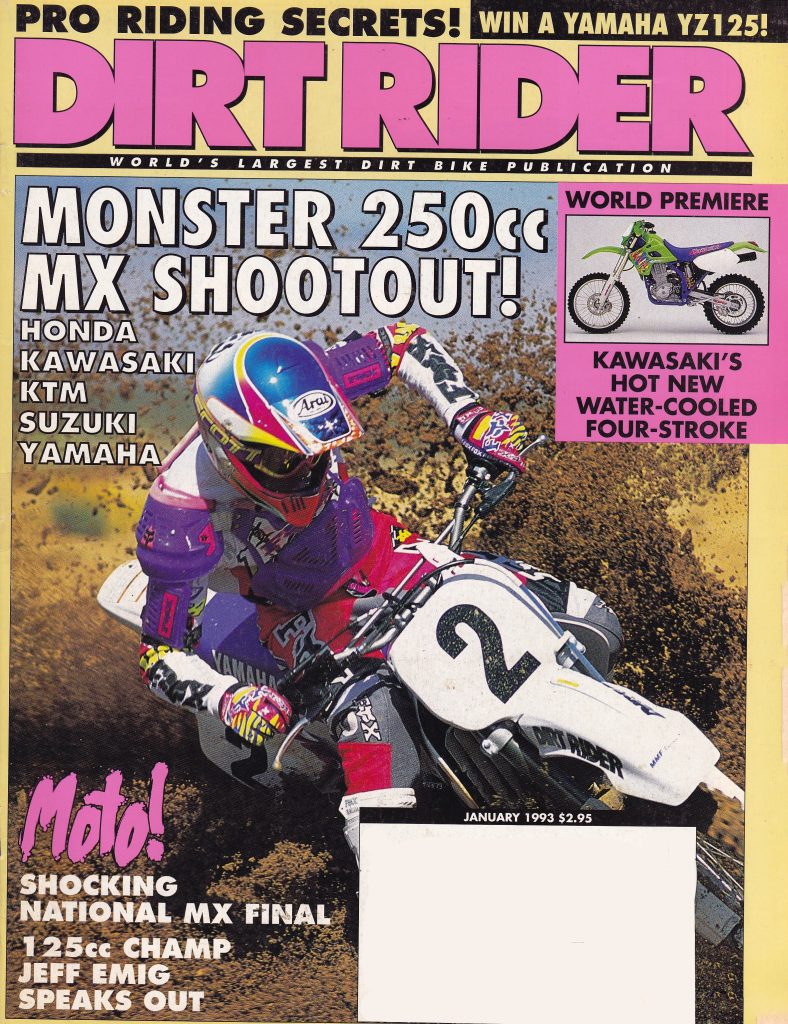 Epic Fox Racing gear and more KLX650 talk grace the cover of Dirt Rider’s January 1993 issue. Man, gear just looked better back then…
Epic Fox Racing gear and more KLX650 talk grace the cover of Dirt Rider’s January 1993 issue. Man, gear just looked better back then…
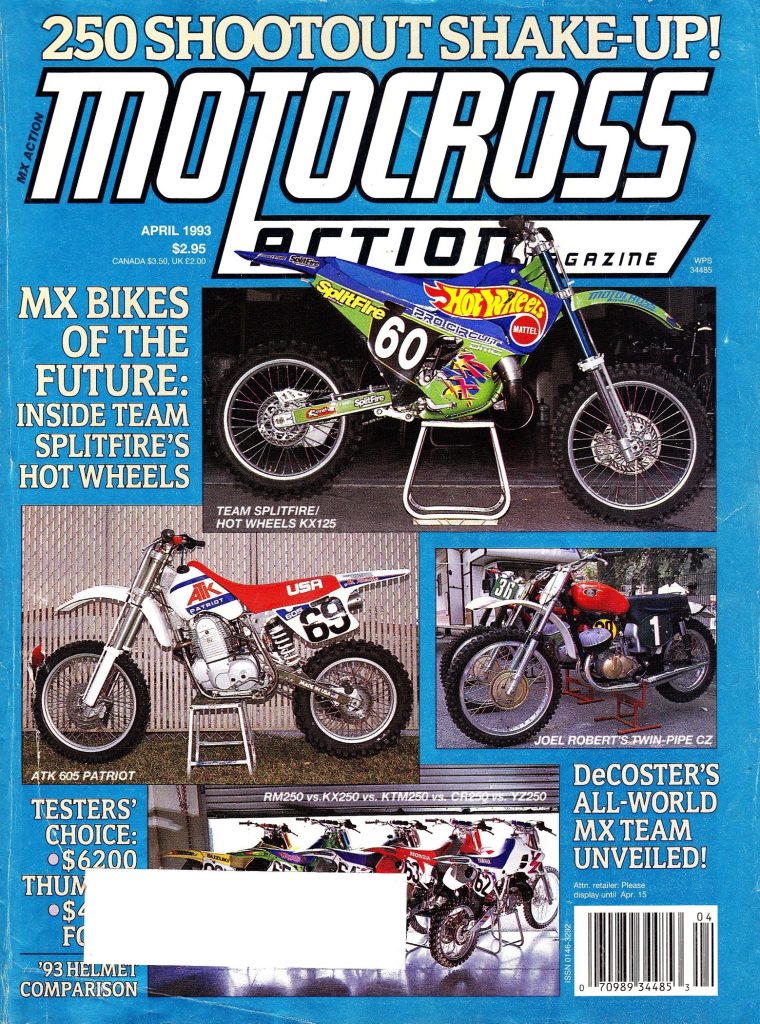 Call me crazy, but I’m glad the look of that spacy Pro Circuit KX125 never caught on. That ATK 605 on the other hand is a beast I would love to have in the garage.
Call me crazy, but I’m glad the look of that spacy Pro Circuit KX125 never caught on. That ATK 605 on the other hand is a beast I would love to have in the garage.
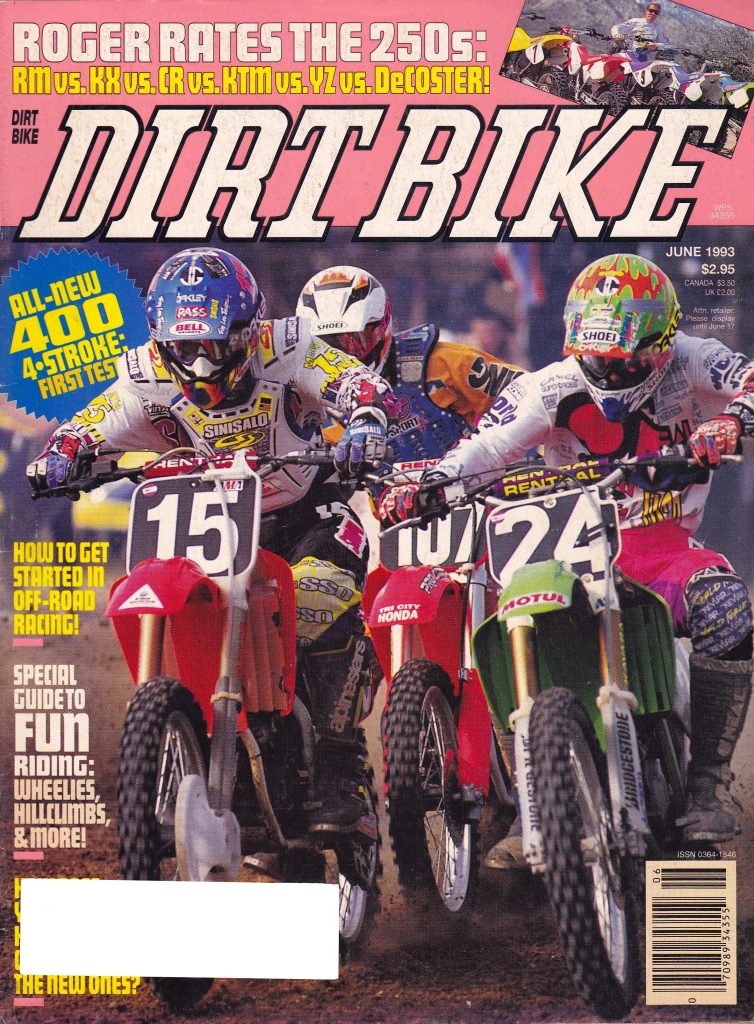 After retiring from Honda, Roger De Coster spent a couple of years moonlighting as an editor for Dirt Bike magazine. Eventually, he would return to racing as the manager of Team Suzuki and put an end to his aspirations as a highly-paid magazine mogul.
After retiring from Honda, Roger De Coster spent a couple of years moonlighting as an editor for Dirt Bike magazine. Eventually, he would return to racing as the manager of Team Suzuki and put an end to his aspirations as a highly-paid magazine mogul.
In this shootout rundown, we are going to review how the five major 250 contenders faired in the three major enthusiast magazines of the time. In 1993, that was Motocross Action, Dirt Bike, and Dirt Rider. As a bonus, Dirt Bike had five-time World Motocross champion Roger De Coster do his own shootout of the big five, and I will include his rankings here as well.
Here is a rundown of the 250 class of 1993 and how they stacked up at the time.
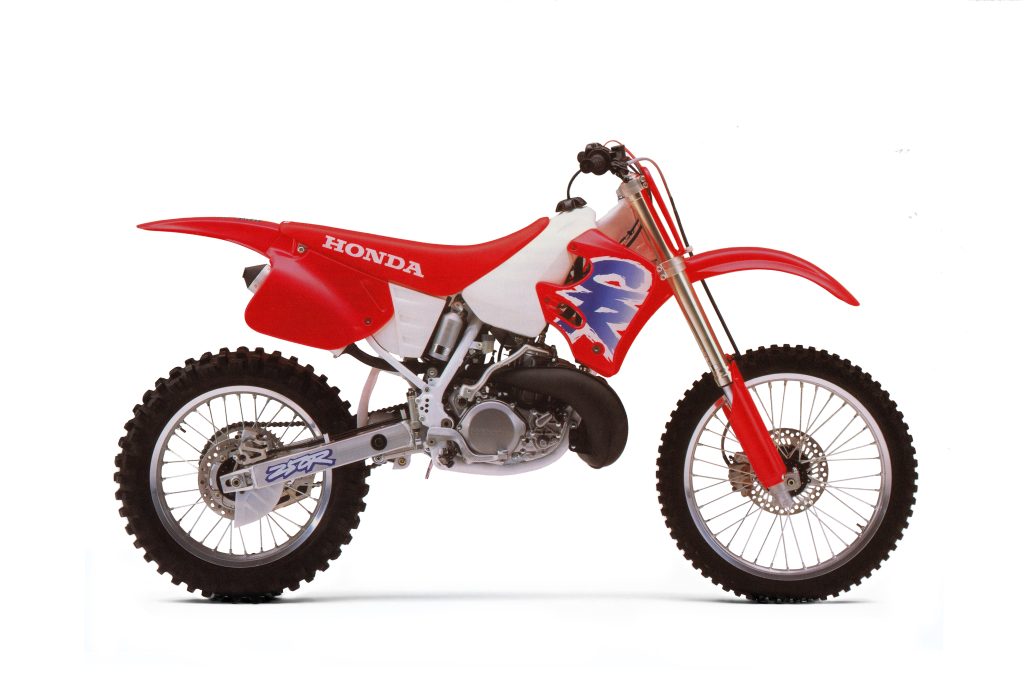 1993 Honda CR250R Shootout Rankings: Motocross Action – 1st (out of 5) Dirt Bike 3rd (out of 5) Dirt Rider – 1st (out of 5) The Man – 1st (in a tie with the YZ out of 5)
1993 Honda CR250R Shootout Rankings: Motocross Action – 1st (out of 5) Dirt Bike 3rd (out of 5) Dirt Rider – 1st (out of 5) The Man – 1st (in a tie with the YZ out of 5)
 Nothing on the track was as fast, flickable, or fire-breathing as Honda’s CR250R in 1993 Photo Credit: Dirt Bike
Nothing on the track was as fast, flickable, or fire-breathing as Honda’s CR250R in 1993 Photo Credit: Dirt Bike
 1993 Honda CR250R Overview: All-new in 1992, Honda’s CR250R was the most Supercross-focused machine in the class. Its redesigned motor put out tons of usable thrust and its slim ergonomics and tight turning made carving up the track a dream. Its new Nuclear Red plastic was fade-prone, its forks were awful, it shook its head like a puppy straight out of the pool, and its chassis was prone to cracking, but for hardcore racing, it was hard to beat.
1993 Honda CR250R Overview: All-new in 1992, Honda’s CR250R was the most Supercross-focused machine in the class. Its redesigned motor put out tons of usable thrust and its slim ergonomics and tight turning made carving up the track a dream. Its new Nuclear Red plastic was fade-prone, its forks were awful, it shook its head like a puppy straight out of the pool, and its chassis was prone to cracking, but for hardcore racing, it was hard to beat.
For 1993, Honda looked to build on that success while also rectifying the suspension and reliability issues suffered by their ’92 machine. First up was new plastic that improved durability by adding additional pigment to prevent fading (and reduce the ugly white marks when bent) and a revised chassis that retained the basic geometry of 1992 but added .2mm of thickness to all the tubing and additional bracing in critical areas. This resulted in a five percent increase in chassis stiffness and a substantial reduction in the cracking issues observed in 1992. New suspension components front and rear looked to improve the CR’s notoriously poor suspension performance while the fantastic motor package remained largely unchanged aside from a new intake and redesigned reed valve.
On the track, the 1993 CR250R turned out to be an improved version of the Supercross title-winning ’92 machine. The motor continued its class dominance with a massive midrange hit and blistering top-end performance. The new CRV (Composite Racing Valve) motor lacked the low-end torque of earlier Honda designs, but intake changes for ’93 boosted low-end response and smoothed the transition into the midrange. These changes made the CR easier to ride but it remained a blisteringly fast machine. Once on the pipe, nothing was as fast as the nitro-powered CR.
As in 1992, the CR remained a scalpel on the track with razor-sharp turning and a flickable feel. Tight turns were the CR’s stock-in-trade, and nothing besides the RM had a prayer of cutting underneath the red machine. Headshake under deceleration continued to be epically violent and the Honda was known to rip its rider’s hands clean off the bars once the front end started dancing. While many riders found this a willing tradeoff for its incredible turning, not everyone was willing to tempt fate at the end of a long moto on the hyperactive CR.
As with every CR250R since 1988, the Honda’s real Achilles’ heel was its grim stock suspension. The new forks were slightly better than in 1992 but far worse than any of the other Japanese machines. Only the KTM and its WP components were rated below the Honda’s harsh Showa units. The new Showa shock was rated higher than its forks, but it still trailed the KX and YZ by a wide margin.
In the final rankings, the CR’s fortune came down to priorities. Motocross Action and Dirt Rider were intoxicated by the Honda’s endless pull, flawless clutch, slick shifting, impeccable brakes, and razor-sharp manners. For them, those virtues were more than enough to overlook its cranky suspension and spooky fits of headshake. At Dirt Bike, however, the Honda’s utter lack of suspension finesse was just too big of an issue to overlook when faced with the magic carpet ride Kawasaki delivered in 1993. For De Coster, the power of the Honda and overall competence of the Yamaha delivered a split decision with The Man ranking both machines as equally effective for very different reasons.
 1993 Yamaha YZ250 Shootout Rankings: Motocross Action – 2nd (out of 5) Dirt Bike – 2nd (out of 5) Dirt Rider – 3rd (out of 5) The Man – 1st (in a tie with the CR out of 5)
1993 Yamaha YZ250 Shootout Rankings: Motocross Action – 2nd (out of 5) Dirt Bike – 2nd (out of 5) Dirt Rider – 3rd (out of 5) The Man – 1st (in a tie with the CR out of 5)
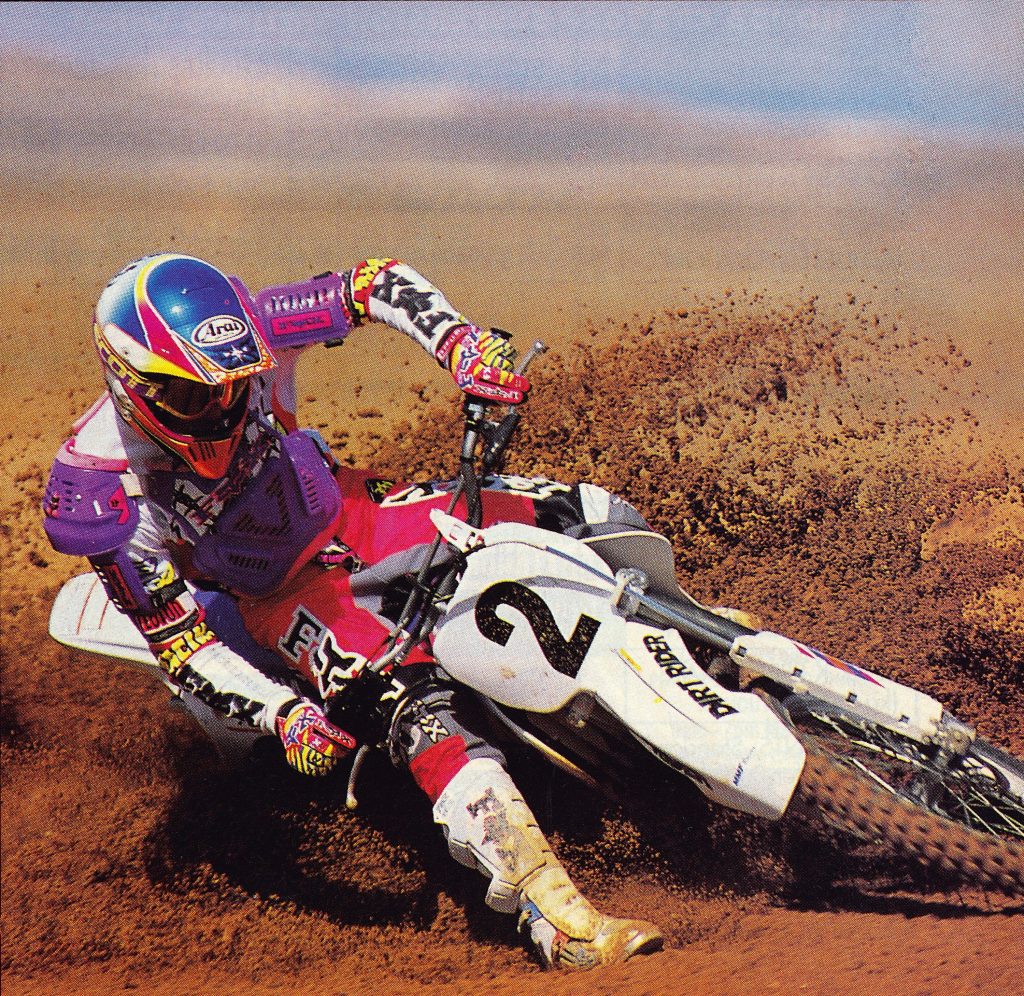 All-new for 1993, the YZ offered a great do-it-all package that excelled with overall competency rather than verve. Photo Credit: Dirt Rider
All-new for 1993, the YZ offered a great do-it-all package that excelled with overall competency rather than verve. Photo Credit: Dirt Rider
1993 Yamaha YZ250 Overview: After several years of refinements to their 1988 design, Yamaha finally came out with an all-new 250 machine in 1993. The reimagined YZ featured all-new bodywork, a redesigned chassis, and revamped suspension. The basic YPVS (Yamaha Power Valve System) motor remained largely unchanged from its 1982 roots, but a decade of refinements and an all-new intake and exhaust promised increases in horsepower and torque for 1993.
On the track, the 1993 YZ250 proved to be an upgraded version of the machine that many riders loved in 1992. Yamaha claimed the new chassis was twenty percent stiffer than the year before and that added robustness could be felt in the rough. The revised motor was incredibly flexible with better bottom-end torque than any other machine besides the KTM and a solid midrange punch. Top-end performance was somewhat flat but the YZ could be revved out in a pinch. The motor’s excellent response, strong midrange, and broad pull made it a hit with riders of all skill levels and many riders picked it as having the best overall powerband in the class.
The chassis’ newfound strength gave the YZ a solid feel and the new slimmer ergonomics made moving around easier than ever. Most riders liked the YZ’s new feel, but a few thought the machine could have benefited from a taller seat. Overall handling was excellent if you wanted a machine that could cover all the bases. Turning was not as aggressive as the Honda and Suzuki with the YZ requiring more effort and proper body positioning to get the front end to bite in hard and slick conditions. Stability, however, was much better than the red and yellow machines with nary a twitch at speed. In most conditions, the YZ offered the best combination of nimbleness and stability and was the only machine that was reasonably adept at both.
Like the chassis, the YZ’s suspension delivered a performance that got the job done without a lot of fanfare. The new Kayaba forks and shock were plush and well controlled and ranked only behind the Kawasaki in most riders’ rankings. Some riders complained about the YZ’s rear shock dropping excessively under acceleration, but even with this peccadillo, the Yamaha’s damper was rated the second best in the 1993 250 field.
In the final rankings, it is interesting that only De Coster picked the YZ as the top machine available (albeit in a tie with the Honda) in 1993. Despite offering the widest powerband, great do-it-all handling, and solid suspension, the best it could manage in the big three magazines was a second. Without the allure of the Honda’s horsepower and the unbelievable ride of the Kawasaki, the YZ was forced to play second fiddle with overall competence as its main calling card.
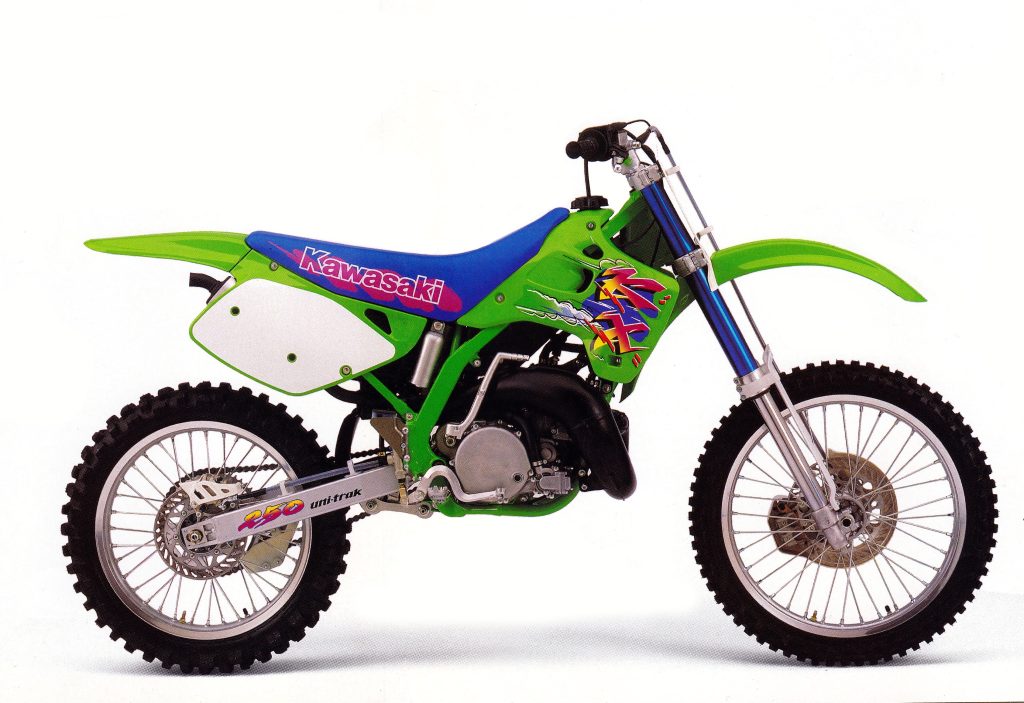 1993 Kawasaki KX250 Shootout Rankings: Motocross Action – 3rd (out of 5) Dirt Bike – 1st (out of 5) Dirt Rider – 2nd (out of 5) The Man – 4th (out of 5)
1993 Kawasaki KX250 Shootout Rankings: Motocross Action – 3rd (out of 5) Dirt Bike – 1st (out of 5) Dirt Rider – 2nd (out of 5) The Man – 4th (out of 5)
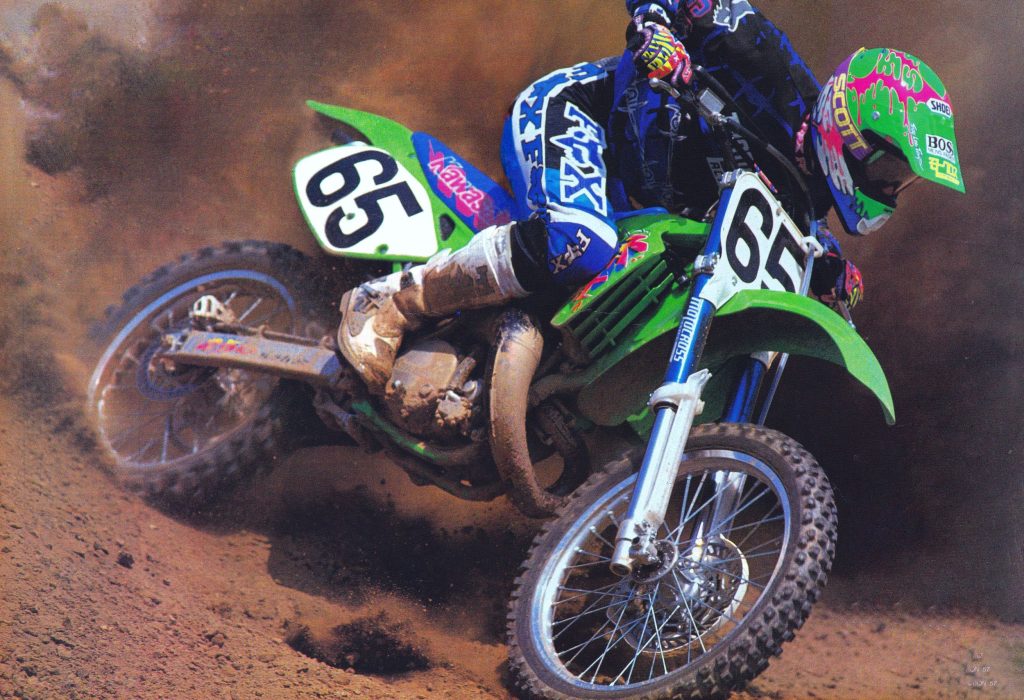 Big, powerful, and blessed with the best suspension in the class, the KX250 had a lot going for it in 1993. Photo Credit: Motocross Action
Big, powerful, and blessed with the best suspension in the class, the KX250 had a lot going for it in 1993. Photo Credit: Motocross Action
1993 Kawasaki KX250 Overview: In 1990, Kawasaki introduced its first perimeter-framed KX250 to huge success. Magazine editors and consumers loved the wild styling and potent motor performance that the all-new machine provided. The chassis was a bit too large and the handling was slightly quirky, but riders snapped up the radical new KXs in droves.
In 1992, Kawasaki introduced the second generation of their perimeter platform to a less enthusiastic response. The new bike addressed some reliability issues with the original perimeter design and added innovations like a fully floating front disc, but the all-new longer-stroke motor provided a mellow and electric style of power that was good for lap times but boring to ride. The new chassis was stiffer and more stable, but many riders did not care for its more reluctant turning. Big and tall pilots did appreciate the KX’s roomy ergonomics, but many riders of lesser stature found the Kawasaki too bulky and heavy feeling for comfort. While the motor and chassis proved controversial, no one complained about the KX’s incredible suspension. Here, the green machine whipped the field with ultra-plush components front and rear.
For 1993, Kawasaki looked to improve their 250 fortunes by cutting weight and spicing up their 249cc mill. To boost power, they added an all-new cylinder which featured revised porting and a redesign of the KIPS (Kawasaki Integrated Powervalve System) to provide more precise port timing control. A revised exhaust and lighter flywheel were added to increase midrange power and improve engine response. The perimeter frame remained but Kawasaki reduced the wall thickness throughout to reduce weight and dial in a bit more compliance. The basic bodywork looked similar to the 1992 but Kawasaki redesigned the front fender to be slimmer and lighter and trimmed the thickness of the tank to further save weight. All told, the KX250 dropped a remarkable six pounds of weight in 1993.
On the track, the KX250 offered a much different personality than the year before. The incredibly supple suspension remained but the new motor ran completely differently than the mellow ’92. The new motor started pulling later and hit much harder in the midrange than the old mill. Top-end power was greatly improved as well and the KX pulled harder and farther on top than any machine other than the CR. The new mid-and-up powerband was more difficult to ride but substantially faster than the ‘91 or ‘92 KX. Fast guys loved the newfound punch and stronger top-end pull but off-road enthusiasts and less experienced riders lamented the loss of the old motor’s flexibility.
On the handling front, the KX remained a big and unwieldy-feeling machine. The six-pound weight loss helped but the overall chassis and layout were still much larger than any other machine in the class. In slick flat turns, the KX’s front end struggled to find a bite and the machine was much happier bouncing off a berm on the outside than trying to dive to the inside. Flowing the high line and keeping up momentum were the best techniques to employ on the KX and here the machine was in its element. High-speed stability was excellent and the KX was an absolute freight train on fifth-gear straights. With its incredible suspension and rock-solid feel, the KX could be bombed through rough high-speed sections that would have terrified a pilot on an RM or CR. That suspension was by far the KX’s biggest advantage and no other machine in 1993 offered anything close to its combination of comfort and control.
In the final standings, the KX racked up one overall victory based largely on that suspension prowess. If plushness, stability, and comfort were your top priorities then the KX250 was in a class all by itself. For Dirt Bike, that was enough to give the green machine the win, but for the others, the KX’s mushy brakes, clumsy turning, demanding motor, and Paul Bunion feel dropped it down in the final standings.
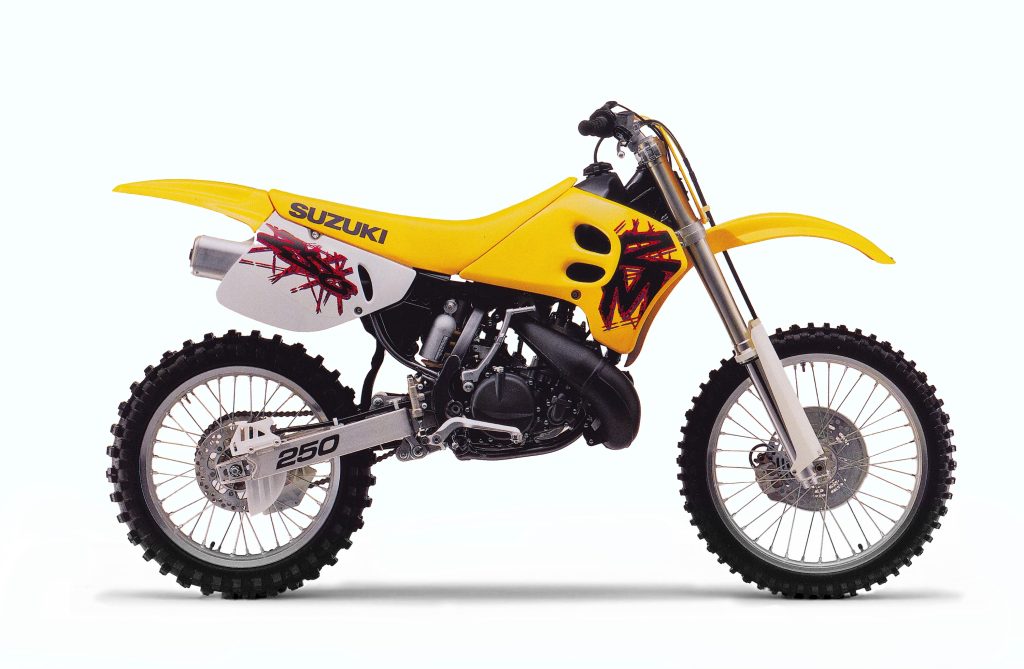 1993 Suzuki RM250 Shootout Rankings: Motocross Action – 4th (out of 5) Dirt Bike – 4th (out of 5) Dirt Rider – 4th (out of 5) The Man – 5th (out of 5)
1993 Suzuki RM250 Shootout Rankings: Motocross Action – 4th (out of 5) Dirt Bike – 4th (out of 5) Dirt Rider – 4th (out of 5) The Man – 5th (out of 5)
 Air Coop: All-new for 1993, the RM250 offered fresh looks, great turning, and a burst motor that launched the yellow machine out of every corner. Photo Credit: Motocross Action
Air Coop: All-new for 1993, the RM250 offered fresh looks, great turning, and a burst motor that launched the yellow machine out of every corner. Photo Credit: Motocross Action
1993 Suzuki RM250 Overview: Redesigned for 1993, the RM250 offered a very specific flavor of 250 performance. Ever since its transition to a case-reed motor in 1989, the RM had delivered a narrow but potent style of power that came on fast and signed off quickly. This style of motor was well-suited for Supercross-style circuits where quickness was king, but less at home in the great outdoors.
This Supercross personality followed through to the RM’s handling with the yellow machines favoring turning over all else. High-speed stability was not in the Suzuki’s vocabulary and the RMs danced around the track like a cat on a hot tin roof. While not everyone was on board with this frenetic style of machine, the RM250s of the early nineties did have their supporters. Many riders loved them for their Avant-guard styling, lightning-quick power, and jump-anything performance.
In 1993, Suzuki looked to refine their 250 package by beefing up the frame, cleaning up the ergonomics, and broadening out the power. An all-new frame delivered a 35% increase in rigidity and redesigned bodywork offered a new look and slightly thicker midsection. At the time, this was an interesting move by Suzuki. Nearly everyone else was moving to make their bikes thinner while Suzuki was spacing out their airbox and radiator shrouds to give the rider a better hold on the bike. While not everyone at the time thought this was a great idea, many pilots did appreciate the added grip the thicker midsection provided. In addition to being thicker, the new bodywork was quite a departure visually. All-new shrouds wrapped
around the tank à la the KTM and KX and a new seat carried farther up the tank for increased comfort. The new gunmetal frame and all-yellow bodywork was as understated as the ’92 version was outlandish, and most racers thought the move back to a more traditional look was an improvement for 1993.
On the motor front, the RM retained the case-reed configuration it had used since 1989 but added an all-new cylinder, redesigned head, reshaped intake, larger airbox, revamped exhaust, and new carburetor. Up front, the 45mm Showa forks received thinner-walled tubing to improve feel and save weight and a new oil-lock system to improve comfort when bottoming out. In the rear, the Full Floater suspension was redesigned with a revised linkage and an all-new Showa shock that featured a larger piston for improved oil flow and a new fade-resistant fluid for long-lasting performance. New materials for the brake pads improved bite and the move to a solid-mounted bar clamp alleviated the complaints riders had voiced in 1992 about the bars wiggling under hard use.
On the track, the 1993 RM250 proved to be an improved version of the bike it had been since 1989. The new motor continued to offer a ton of hit but not much else. Low-end torque and top-end pull were not on the menu with the RM delivering all of its prodigious thrust in one big midrange blast. The motor changes for ’93 added a bit of grunt to the low-end and a tad more burst in the middle but not enough of either to change the RM’s personality. It remained a one-dimensional power package that spooled up quick, came on with a bang and demanded another shift. Sections of the track that could be negotiated in one gear on the Honda required three shifts on the Suzuki. It was a rat-a-tat-tat style of power that was fun to ride but demanding to race.
On the handling front, the new chassis only amplified the Suzuki’s excellent turning manners. The stiffer frame, improved ergonomics, and well-damped forks allowed the RM to cut under every under machine but the Honda. In this category, only the CR was in the RM’s ballpark for steering accuracy and precision. At speed, the RM continued to be the motocross equivalent of a Tilt-A-Whirl as it jumped, jived and juked all over the track. Unlike the CR250, which tended to shake its head when coming down from speed, the RM liked to float above the track and dance around under acceleration. Neither bike was suitable for Baja, but many riders found the Honda’s headshake preferable to the Suzuki’s general schizophrenia at speed.
Some of this Jekyll and Hyde handling behavior in 1993 was certainly attributable to the RM’s poorly damped shock. While the new forks performed admirably, the rear damper was a hopping and swapping mess that hated square-edged bumps and refused to take a proper set under acceleration. This jacked-up rear messed with the chassis’ balance and exasperated its already aggressive geometry. Thankfully, however, the RM’s jumping manners continued to be impeccable. In short, nothing was as feathery, flickable, and fun to jump in ‘93 as the RM250. Its quick-building power, comfortable layout, and lithe chassis helped the RM conquer any gap with ease. On a Supercross track, the RM was in its element blasting from corner to corner and making quick work of tricky rhythm sections. Here, its stiff shock and wandering high-speed manners were not a concern and the RM could be very effective with the right rider at the controls.
In the end, the RM’s hyperactive nature proved too polarizing to win over the hearts and minds of the magazine editors in 1993. The bike was plenty of fun and many riders enjoyed playing on it, but very few of them thought it offered the best combination of handling, power, and suspension for racing. It was a bike that could excel in the right environment, but that did not translate to the types of tracks 98% of the buying public were likely to find themselves riding on.
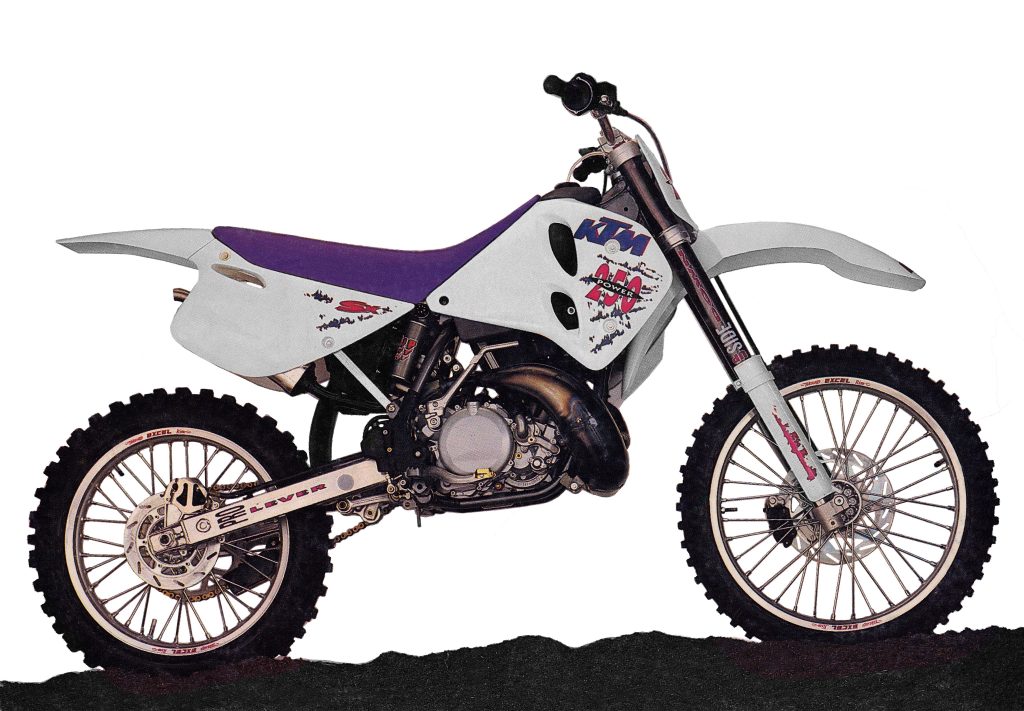 1993 KTM 250SX Shootout Rankings: Motocross Action – 5th (out of 5) Dirt Bike – 5th (out of 5) Dirt Rider – 5th (out of 5) The Man – 3rd (out of 5)
1993 KTM 250SX Shootout Rankings: Motocross Action – 5th (out of 5) Dirt Bike – 5th (out of 5) Dirt Rider – 5th (out of 5) The Man – 3rd (out of 5)
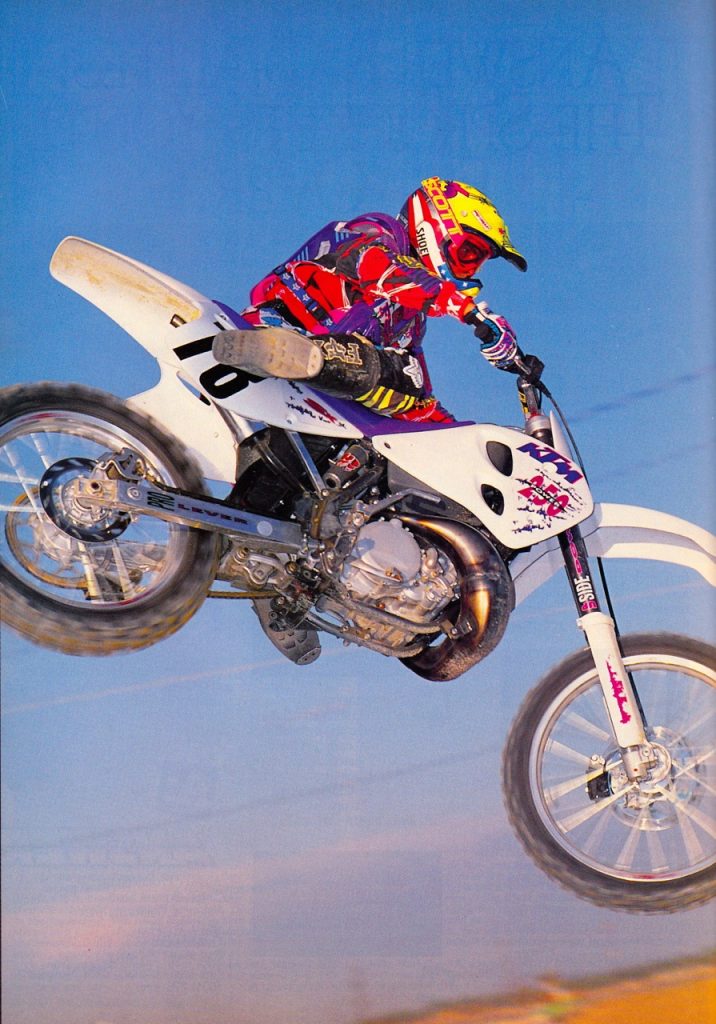 The third all-new entry of the 1993 250 field, the KTM 250SX was a good machine in need of a bit more polish. Photo Credit: Karel Kramer
The third all-new entry of the 1993 250 field, the KTM 250SX was a good machine in need of a bit more polish. Photo Credit: Karel Kramer
1993 KTM 250SX Overview: Today, KTM is an off-road powerhouse, but in 1993 they were just coming out of bankruptcy and serious restructuring of their business. Well- regarded in Europe, they had failed to break through into the motocross mainstream in America during the 1980s. The American market’s infatuation with Japanese machines, a lack of race team support, and a poor dealer network all contributed to KTM’s difficulty at the time. In 1990, KTM finally got serious about the American market with an all-new “Broc Glover replica” machine. The new 250 Motocross was developed with the help of Glover during the 1989 GP season and featured a move to a more “Japanese” style layout and feel.
The new machine proved very popular with the off-road crowd, but motocross racers still found the motor and suspension performance somewhat lacking. In 1991, KTM added a race team to their American effort by hiring long-time Kawasaki test rider Mike Fisher to race their machine on the AMA circuit. On the mint green KTMs, Fisher would card some of the best finishes of his career and deliver the brand several top-four finishes during the 1991 Supercross season.
That same year, KTM was forced into bankruptcy and nearly suffered the same fate as so many of its Old-World competitors. CZ, Maico, Bultaco, and Husqvarna had all once been motocross powerhouses, each one falling prey to the clever and imminently efficient Japanese. Thankfully, however, KTM weathered this storm and came out of bankruptcy a leaner and more product-focused competitor. The new KTM was divided into four separate divisions: radiators, bicycles, tooling, and motorcycles. Guided by Stefan Pierer, the reinvented KTM Sportmotorcycle set about rebuilding the brand’s reputation and bringing them back to profitability.
The first major product in this rebuilding plan was the redesigned 1993 KTM 250SX. Set to underpin an entire lineup of 250cc and 300cc motocross, Enduro, and cross-country machines, the new platform featured an all-new frame, redesigned bodywork, a reworked motor, upgraded suspension, and a move away from the mint green of ’91 and ’92 to a nineties-appropriate purple and pink. Developed with the assistance of Mike Fisher, the new machine featured slimmer ergonomics, American-focused suspension settings, and more aggressive handling targets than traditional European machines of the time. It was a bike bred for American racing and aimed at taking a bite out of Japan’s stranglehold on the global motocross market.
On the track, the redesigned KTM 250SX proved to be competitive, but still a notch behind what most magazine editors were looking for in 1993. The new motor produced a ton of torque off idle but not much after that. Midrange and top-end power were lacking compared to its rivals but the powerband was friendly and easy to ride. This worked very well off-road and there the KTM was in its element. On a motocross track, however, its short powerband meant a lot of shifting to keep up with its competitors. Much like the Suzuki, the KTM was quick from corner to corner but wide-open tracks put it at a distinct disadvantage. Clutch feel and shifting precision were also a step behind the best in the class, but the motor was competitive if the track was tight and not too wide open.
The new slimmer bodywork and redesigned frame made it easier than ever to move around on the KTM but no one much cared for the SX’s rock-hard seat and Euro-spec controls. None of them worked poorly, but many test riders noted the odd shape and oversized feel they offered. If all you rode was the KTM you got used to it but switching back and forth between the Japanese and Austrian machines it was noticeable.
As in the past, the biggest challenge for the KTM turned out to be its handling and suspension. New settings for the suspension were aimed at catering more to America’s jump-filled tracks but most riders thought the WP forks were poorly valved and harsh in action. Mike Fisher might well have been able to race Supercross on them, but they beat up everyone else. In the rear, the KTM offered a much more acceptable action, and most riders thought the bike could be raced without sending the stock damper out to be massaged. As with the forks, the shock transmitted more of the track to the rider’s backside than most pilots appreciated (the concrete seat probably did not help this), but at least its action was not as hopeless as the RM’s.
On the handling front, the KTM offered a unique feel that was very different from the Japanese machines. Once again, this may have been a culprit of the KTM’s many masters who seemed to want a machine that was as comfortable slithering through the trees back East as it was blasting berms at Glen Helen. The tight steering lock and geometry that allowed the bike to maneuver quickly around obstacles off-road never quite felt at home when faced with the higher speed of a motocross track. The KTM preferred to be “steered” around turns rather than flow through them and while this was an effective way of changing direction many riders found it difficult to come to terms with. There was also a bit of headshake at speed, but nothing on the level of the Honda.
Overall, the KTM proved to be a bit too slow, a bit too harsh, and a bit too different to unseat any of the traditional Japanese brands in the ’93 magazine shootouts. De Coster did pick it over the RM and KX based on the KTM’s strong low-end power and his ability to pound the stock suspension into submission, but his opinion was a definite outlier. For most mere mortals, its one-dimensional power, unique feel, and harsh suspension pushed it to last place in the shootout standings.




